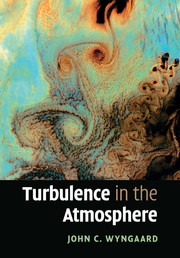Book contents
- Frontmatter
- Contents
- Preface
- Part I A grammar of turbulence
- 1 Introduction
- 2 Getting to know turbulence
- 3 Equations for averaged variables
- 4 Turbulent fluxes
- 5 Conservation equations for covariances
- 6 Large-eddy dynamics, the energy cascade, and large-eddy simulation
- 7 Kolmogorov scaling, its extensions, and two-dimensional turbulence
- Part II Turbulence in the atmospheric boundary layer
- Part III Statistical representation of turbulence
- Index
1 - Introduction
from Part I - A grammar of turbulence
Published online by Cambridge University Press: 11 April 2011
- Frontmatter
- Contents
- Preface
- Part I A grammar of turbulence
- 1 Introduction
- 2 Getting to know turbulence
- 3 Equations for averaged variables
- 4 Turbulent fluxes
- 5 Conservation equations for covariances
- 6 Large-eddy dynamics, the energy cascade, and large-eddy simulation
- 7 Kolmogorov scaling, its extensions, and two-dimensional turbulence
- Part II Turbulence in the atmospheric boundary layer
- Part III Statistical representation of turbulence
- Index
Summary
Turbulence, its community, and our approach
Even if you have not studied turbulence, you already know a lot about it. You have seen the chaotic, ever-changing, three-dimensional nature of chimney plumes and flowing streams. You know that turbulence is a good mixer. You might have come across an article that described the intrigue it holds for mathematicians and physicists.
Unless a fluid flow has a low Reynolds number or very stable stratification (less dense fluid over more dense fluid), it is turbulent. Most flows in engineering, in the lower atmosphere, and in the upper ocean are turbulent. Because of its “mathematical intractability” – turbulence does not yield exact mathematical solutions – its study has always involved observations. But over the past three decades numerical approaches have proliferated; today they are a dominant means of studying turbulent flows.
Turbulence has long been studied in both engineering and geophysics. G. I. Taylor's contributions spanned both (Batchelor, 1996). The Lumley and Panofsky (1964) work was my introduction to that breadth, but as Lumley later commented, their parts of that text “just…touch.” Today the turbulence field seems more coherent than it was in 1964, although it still has subcommunities and dialects (Lumley and Yaglom, 2001).
In Part I of this book we focus on the physical understanding of turbulence, surveying its key properties. We'll use its governing equations to guide our discussions and inferences. We shall also discuss the main types of numerical approaches to turbulence.
Information
- Type
- Chapter
- Information
- Turbulence in the Atmosphere , pp. 3 - 26Publisher: Cambridge University PressPrint publication year: 2010
Accessibility standard: Unknown
Why this information is here
This section outlines the accessibility features of this content - including support for screen readers, full keyboard navigation and high-contrast display options. This may not be relevant for you.Accessibility Information
- 1
- Cited by
